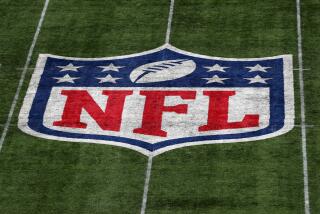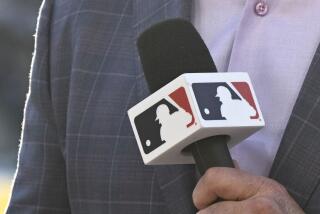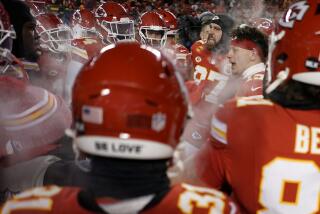NFL future: Feeling a bit woozy
NEW ORLEANS -- Over the last two decades, the NFL seemingly could do no wrong.
The Dallas Cowboys, bought by Jerry Jones for $150 million in 1989, are now valued at $2.1 billion. Twenty of the league’s 32 teams are valued at $1 billion or more.
Eight of the country’s top 15 most-watched TV programs were Super Bowls, and more than 100 million people around the globe are expected to tune in for next Sunday’s matchup between the Baltimore Ravens and San Francisco 49ers. Fans will pay thousands of dollars per ticket just to get inside the Superdome to watch the game in person.
Even after the labor meltdown and player lockout of 2011, when another league might have lost legions of fans, the NFL had a typically captivating season — including the unexpected bonus of Tim Tebow — and grew in influence and popularity.
But fissures have formed in the once-pristine NFL edifice. More than 2,000 former players are suing the league over head injuries, and what they were and weren’t told about the long-term damage of concussions. Junior Seau, among the greatest linebackers in league history, committed suicide last spring and was later found to have a concussion-related brain disease. Seau’s family this week filed a wrongful-death lawsuit against the league. A study released last week shows signs of an ailment similar to Seau’s in five living NFL alumni.
“The culture of the athlete is still too much of a play-through-it, rather than player-safety mentality,” NFL Commissioner Roger Goodell said in November in a speech to the Harvard School of Public Health. “Many players have publicly admitted to hiding concussions and other head injuries.… This is unfortunate, but we are working with players, team doctors and coaches to change that culture. It is changing, but will take more time, resolve, patience, and determination.”
The NFL is considering the drastic move of doing away with kickoffs in the name of player safety. However, Goodell and team owners also have explored the possibility of expanding the regular season from 16 to 18 games, potentially increasing the likelihood of injuries. There also have been discussions about expanding the playoff field from 12 to 14 or 16 teams.
“There’s an uneasy feeling around the NFL, because although the league is arguably more popular than it’s ever been before, there are also these glaring areas of deep concern about player safety on the field, and the players’ health off the field and after their careers are over,” said Michael MacCambridge, author of “America’s Game: The Epic Story of How Pro Football Captured a Nation.”
“I’m convinced that the NFL gets it, and is working very hard to make the game safer. But if you’re a fan, you have to be concerned about some of the trial balloons that have been floated: an 18-game regular season is not just a bad idea for the people who play the game and watch the game, it’s also totally out of step with the cultural mood of the moment. You want to believe that the owners are guided not only by revenue figures but also the greater good of the game.”
The NFL is an incredibly robust enterprise, one that generates $9 billion a year in revenues. It probably would survive the potentially huge damages those class-action lawsuits could bring. But say the league did have to pay a staggering amount in damages. Would high schools face prohibitive insurance premiums to keep football programs going? What about Pop Warner football? Those NFL lawsuits have a devastating ripple effect on football as we now know it.
Already, the league has made several rules changes to protect players, and more are in the offing, angering purists who say the sport has already been tweaked and twisted too much.
“We don’t want to take physical contact out of the game,” Goodell said in his Harvard speech. “But we must ensure that players follow rules designed to reduce the risk of injury.”
The health and safety of players is but one of many challenges the league is facing. Eighteen months after their labor fight was resolved, a palpable tension remains between the NFL and NFL Players Assn. The sides have yet to agree on how to test for illicit use of human growth hormone, even though there are strong suspicions some players are using it.
“It’s a two-way street, and that’s why the NFL and NFLPA need to work together,” said Jed York, chief executive of the 49ers. “Because if you don’t work together on those things, then you just have a fight that doesn’t resolve anything.
“There has to be an honest conversation — not a negotiation — but an honest conversation of, is there HGH in the NFL? If there is, let’s make sure that guys aren’t putting themselves at risk. We need to sit down and solve this problem. We need to make sure it’s a level playing field for everybody. We’re doing that with steroids, with narcotics and things like that. We need to address the next level of performance-enhancing drugs.”
The NFL and NFLPA might have achieved a breakthrough this month on HGH testing, with both sides saying they would be amenable to the type of testing done in Major League Baseball. But the league and the union have been close to such an agreement in the past before digging in, firing salvos at each other, and failing to put a testing plan in place.
The suspicion is that both sides are reticent to begin testing because of the possibility of widespread HGH use in the league and the fallout that could bring.
More hurdles clutter the NFL’s path. There’s the public-relations headache over Goodell’s suspensions of four New Orleans Saints for their roles in the Bountygate scandal, suspensions that were later vacated by arbitrator (and former NFL commissioner) Paul Tagliabue. There was the embarrassment of replacement officials who faltered in place of the locked-out regulars.
Meanwhile, Los Angeles has no team, and the league has no plan for a return to the nation’s second-largest market. There are stadium proposals in Southern California, but the league has yet to act on them. In cities that have teams, the challenge of attracting fans to games only grows as it becomes increasingly easy, comfortable, and inexpensive to watch on TVs, computers, and even mobile devices. What’s more, the once-bulletproof TV numbers have dipped this season, falling off 5% from a year ago.
Making mountains of money is not a problem for the NFL. But there’s no guarantee the league will continue its upward trajectory. Just as a quarterback is taught to keep his head “on a swivel,” the NFL too has to constantly address problems and scan the landscape for new and better business opportunities.
The NFL’s Eric Grubman, a former Goldman Sachs Group investment banker, spends significant time focused on getting fans to come to games, as opposed to watching them from home, where they don’t pay for tickets or parking, buy food and drinks at stadium prices, or wait in line for the bathroom.
“People are tired of economic pressure,” said Grubman, the league’s executive vice president of business operations. “So when they feel it at the gas station, and they feel it with their mortgage payment, and they feel it everywhere else, it’s just natural that they question it more on the ticket.
“Our job is to make sure there’s a ticket price for every fan, and to make sure that every year we give more excitement and more value to that same ticket. That becomes a bigger challenge when people don’t feel good from an economic and financial perspective.”
The New York Jets charged an NFL-high average of $117.94 per ticket this season, and the next four most expensive teams — New England, the New York Giants, Chicago and Dallas — all charged an average of more than $110 per ticket.
“We’ve gotten to a point where it really hurts to go to a football game,” MacCambridge said. “I’ve been to a couple stadiums where, and think about this, this is your first contact with a team. You’re coming there because you love the team, you want to root for the team, and your first contact with the team is: parking $30. You’re not even in the stadium yet, and you’re already out 30 bucks.
“The league does not want to be in a situation where the only teams that sell out are the teams with winning records. Then you don’t have a healthy product.”
The 49ers’ York is building a new stadium in Santa Clara that has all the technological perks befitting a venue in the heart of the Silicon Valley. He wants fans who attend games at the new stadium to have every comfort they now have at their favorite coffee store, and more.
By his thinking, having full stadiums is important not only for the revenues they generate but for the perception of the games to the people watching at home.
“A restaurant isn’t as good if there’s only four people in there,” York said. “When a restaurant is hustling and bustling, it just feels better, the food tastes better because you see everybody else enjoying it. That’s the same thing for any live event. Great bands, if you don’t have a great crowd, then the band isn’t quite as good.
“The same thing goes for the game. If you don’t have a great crowd and people who are interacting with the game, it’s just not the same feel.”
The next generation of NFL stadiums could be markedly different than the ones we now know, Grubman said. He envisions smaller and more intimate venues, possibly more like basketball arenas, with standing-room-only clubs at the corners.
“What if a new stadium we built wasn’t 70,000, but it was 40,000 seats with 20,000 standing room?” he said. “But the standing room was in a bar-type environment with three sides of screens, and one side where you see the field. Completely connected. And in those three sides of screens, you not only got every piece of NFL content, including replays, Red Zone [Channel], and analysis, but you got every other piece of news and sports content that you would like to have if you were at home.
“Now you have the game, the bar and social setting, and you have the content. What’s that ticket worth? What’s that environment feel like to a young person? Where do you want to be? Do you want to be in that seat, or do you want to be in that pavilion?”
Whether it’s player safety, business opportunities, or adjustments to the game itself, Grubman said, the key for the NFL is to be vigilant and bold in its thinking.
“When you’re watched and followed by 200 million people,” he said, “little things can become big things, and when you mishandle those little things, they become giant.”
Twitter: @LATimesFarmer
More to Read
Go beyond the scoreboard
Get the latest on L.A.'s teams in the daily Sports Report newsletter.
You may occasionally receive promotional content from the Los Angeles Times.











